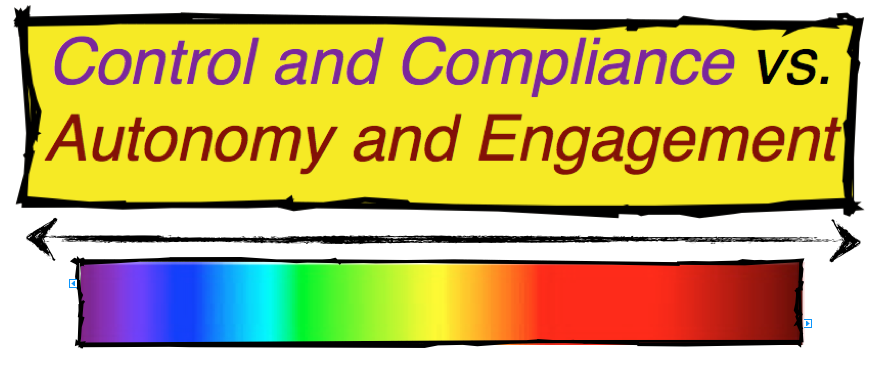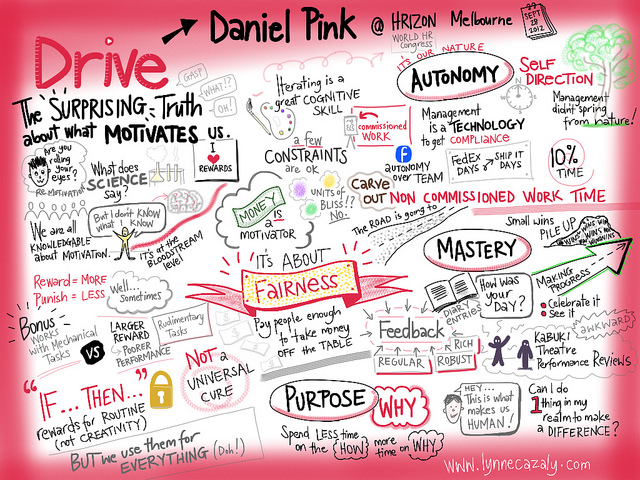|
Over the last several months I have been looking for different books, outside the realm of PE, to read and get new ideas from that are transferrable to my own teaching practice. One of these books, Drive by Daniel Pink, has been a wonderful read that I've thoroughly enjoyed. As I go for my morning runs, I listen to the audiobook version and get loads of great ideas and important thoughts to consider and reflect on in regards to how I run my PE program. Thanks to Lynne Cazaly for her wonderful graphic of Daniel Pink's book. Over the next few weeks, I am going to be blogging on what specifically I am able to take away from Drive and explain how I can apply it to my teaching practice. I will also reflect on some important concepts that Daniel Pink writes about and how these concepts need to be carefully considered when we have an in-depth look at how we teach and assess in PE. For the moment, I want to reflect on control and compliance vs. autonomy and engagement in regards to our instructional practice in PE. It is important to constantly evaluate where our instruction falls on this spectrum. All the science out there indicates with certainty that humans thrive when they feel that they work within environments that foster autonomy and freedom. Whether you work in business, education, engineering and so forth, the key to productivity is autonomy. If this is the case for the workforce in general, what are the implications for our students as they embark on their learning journeys in school? If the science supports the notion that adults are more engaged in their work and more productive in general when they work in environments that promote and foster autonomy, it is obvious that students thrive in the same types of environments within the walls of their own schools. Now, this leads me directly into our teaching and assessing in PE. I have been a strong advocate for allowing students to design their own learning and to be fully engaged in helping to develop the assessment criteria that we use in PE, both formatively and summatively. Have I always done this? Absolutely not. When I reflect on my style of instruction early on in my teaching career, although I thought I was a decent teacher, I certainly did not give my students a lot of freedom. There is a certain fear that comes to mind when giving more control over to the students. Will they actually learn or will they fluff around? How can students be responsible for deciding on their own learning engagements? The questions abound ten fold when it comes to giving students ownership and control over their learning.
I think it is an absolute necessity to involve students in assessment design in PE. Again the science clearly indicates that humans gain much higher levels of motivation that is sustainable over time when they have more freedom and autonomy in their work environment. This science is no different for our students. Our number one goal, in my opinion, should be to create intrinsically motivated students. Intrinsic motivation is at the very heart and essence of success in school and in the workplace. If we can help to develop intrinsically motivated students in our PE classes, everything else comes easy. I guarantee that they will meet and/or exceed all of the student learning outcomes in a unit. They will meet and/or succeed all of the standards and benchmarks that they are required to meet in PE. How can we help to create an environment that encourages autonomy and freedom in PE?
I ask you again to assess where on the spectrum your teaching practice falls. At what times do we need more control? At what times can we give up control? All important factors to reflect on when trying to improve our instructional practice in PE. Let me know your thoughts.
2 Comments
5/12/2013 06:46:28 pm
Andy, as a read the first few paragraphs I come to see the synergy between your experiences and mine...with one caveat, I’m not sure I was prepared to give students freedom or indeed felt that freedom was a good option...at least not in my early career. Autonomy? Well there was something for the last lesson of the term and which was normally expressed in terms of a “kick about” football match. Not what I consider high-quality teaching now! Still, I was young and I learnt.
Reply
7/18/2013 04:23:19 pm
Andy,
Reply
Leave a Reply. |
AuthorKAUST Faculty, Pedagogical Coach. Presenter & Workshop Leader.IB Educator. #RunYourLife podcast host. Archives
September 2022
|
- Welcome
- All Things Teaching and Learning
- The Aligned Leader Blog
- Consulting and Coaching Opportunities
- My TED X Talk
- My Leadership Blog
- Run Your Life Podcast Series
- How PYP PE with Andy Has Helped Others
- Good Teaching is L.I.F.E
- The Sportfolio
- Example Assessment Tasks
- PYP Attitude Posters (printable)
- Publications



 RSS Feed
RSS Feed
